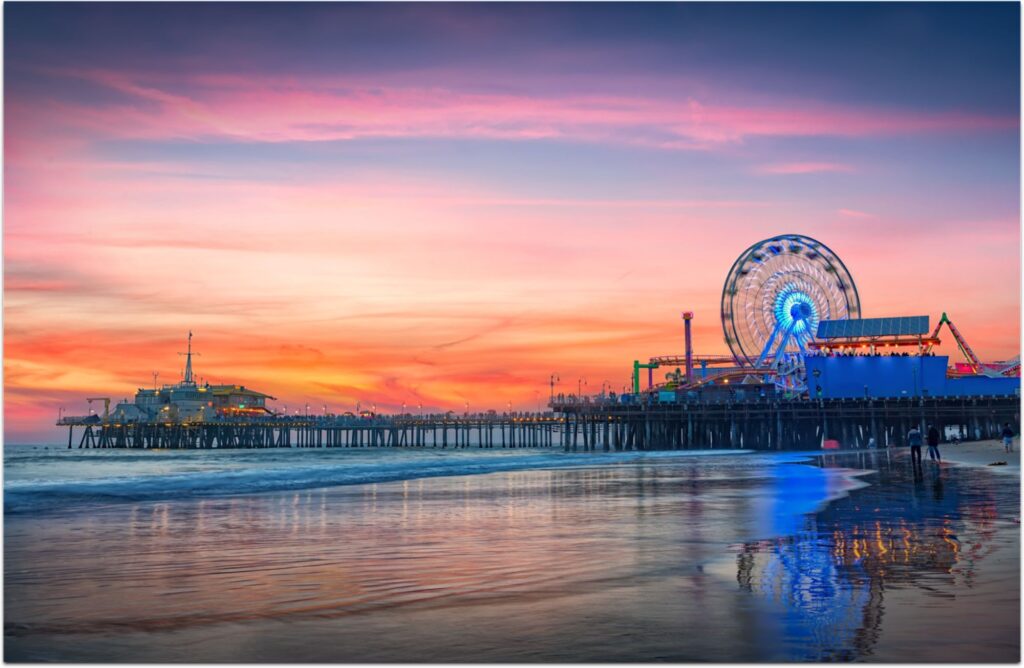A town launched by two entrepreneurs, Colonel Robert S. Baker and Senator John P. Jones of Nevada, the innovative men purchased the Bay city in July 1875 to develop “a prosperous industrial port,” according to the Santa Monica Conservancy. With the city’s exquisite environmental backdrop, the port city quickly went in a new direction, aiming to become a beach resort town and a highly sought-after place to live. 150 years later, the illustrious city lives up to its purpose and is a center for premiere residential properties, fine dining, entertainment, art, and Los Angeles history. “Santa Monica is a global hub of influence behind one of the best backdrops the city has to offer,” said David Kramer, President of Hilton & Hyland.
After the turn of the 19th century, the city built a 1,600-foot-long Municipal Pier, now known as the Santa Monica Pier. In 1916, Charles Loof, famous carousel carver turned amusement entrepreneur, built a newer, wider pier with an amusement park along the south side. The addition of the Looff Hippodrome and its carousel – the last to be constructed by Loof- to an already breathtaking backdrop instantly made the Pier one of the world’s top attractions. With the addition of the Yacht Harbor, Santa Monica Paddleboard Club, and the Manoa Paddleboard Club, the Pier was a hub of influence and lifestyle through the 1950s.
Along with the world-famous Pier, Santa Monica is home to the picturesque Palisades Park, art deco Aero Theatre, and Montana Avenue’s high-end fashion and dining district.
Over 150 of the world’s finest restaurants and retailers sit at the city’s northern edge on Montana Ave. Only minutes from Downtown Santa Monica, this premiere stretch of establishments showcases the city’s unique, upscale style. The acclaimed retail experience has been creatively curated to provide residents and guests with the best selection of dishes and dresses. Whether enjoying the scrumptious sensations at Sweet Lady Jane, the generously-portioned burgers at Father’s Office, or searching for designer apparel at Savannah, Montana Avenue has selections for every style.
An art deco landmark in Santa Monica, the Aero Theatre, was built in 1939 as a 24-hour single-screen movie house. The swank theatre built by the Donald Douglas Company is an anchor to Santa Monica’s posh Montana Avenue section. With appearances in Donnie Darko (2001), 10 to Midnight (1983), and Masquerade (1988), the theatre has been a constant in Los Angeles popular culture. Now serving as a home for intellectual discussion and acclaimed indie films, the Aero Theatre has withstood the everchanging theatre landscape and over 80 years of Hollywood’s fluidity to become a tribute to Santa Monica’s cinematic past.
Estates such as 1011 Georgina Avenue blend sophistication with understated elegance to create works of art. Represented by David Kramer and Andrew Buss, this breathtaking Modern showcases dramatic architectural moments throughout the entire address. Built and designed by Kevin McCauley, the estate is a masterpiece full of one-of-a-kind amenities.
1011 Georgina Ave, Santa Monica. Represented by David Kramer and Andrew Buss. Photo Credit: Anthony Barcelo
The homes in the North of Montana neighborhood showcase designs crafted by some of the most renowned architects. “There are impressive historic homes such as 405 Palisades Avenue, a home I was honored to sell, which has been designated a Santa Monica Landmark,” Buss said. “This iconic, well-articulated 20th Century American Craftsman earned esteemed Mills Act historic status, the single most important preservation program in California.”
